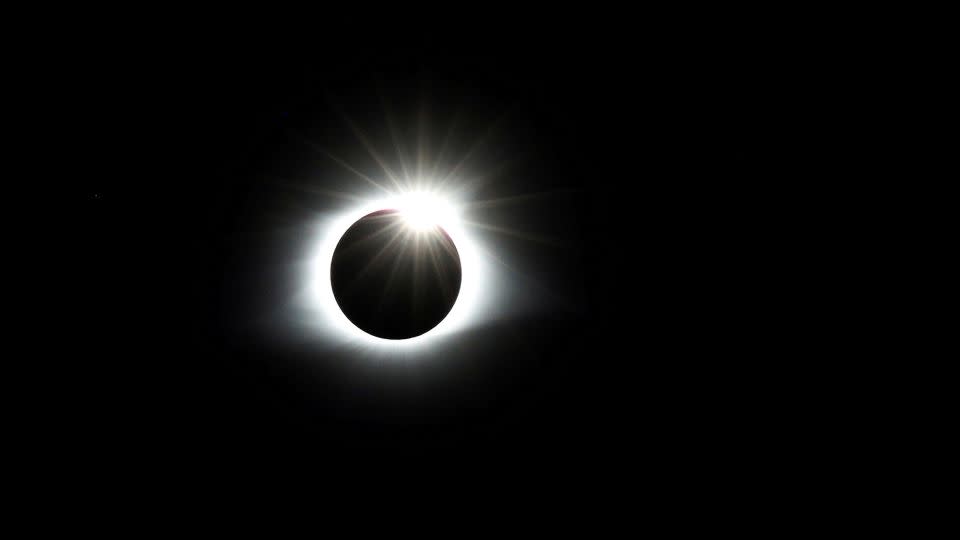If you’re planning to see the epic total solar eclipse that will dance across North American skies on Monday, you should aim to travel as close to the center of the celestial show’s path as possible.
The new map calculations have raised some concerns that the path of totality, where it is possible to see the moon completely blocking the sun, is slightly narrower than NASA calculated. This means some cities along the side of the route that expect to experience a second or two of pitch darkness may be left out.
NASA has not changed its predictions, but the space agency notes that there is some uncertainty in mapping the path of the eclipse.
“Calculations using a slightly larger radius for the size of the Sun reveal that the eclipse path is slightly narrower,” NASA spokeswoman Karen Fox said in an emailed statement. “This difference will only affect cities at the far end of the totality path, where general predictions are difficult – a few city blocks one way or another could mean 20, 10 or 0 seconds of totality.”
NASA scientists and other experts recommend that viewers focus on the middle of the road rather than the perimeter.
Professor of astronomy and astrophysics at Villanova University, Dr. “I will never, ever be anywhere near the edge of this totality because it is the difference between night and day,” said Edward Guinan.
mapping the moment
Recent questions about a potentially changing path have focused on a new map calculated by Guildford, England-based software developer John Irwin and published on a web page called Besselian Elements.
Guinan said the study has not been thoroughly reviewed by scientists. Even if the NASA map is wrong, Irwin’s calculations show it’s only a few thousand feet from the edges.

Irwin did not immediately respond to an emailed request for comment Friday.
But in science, few things are certain. NASA also acknowledges that precise measurements of the eclipse path are difficult to determine.
“(P)recise eclipse prediction has brought new attention to a small but real uncertainty about the size of the Sun,” NASA said. “Uncertainty in Earth’s rotation may also affect eclipse predictions at this level.”
Determining the exact measurement of the sun’s size is extremely difficult because it is a “fuzzy surface,” Guinan explained.
He noted that the sun may be expanding slightly at the moment because our star is currently going through a period of maximum magnetic activity, which “may cause the sun to swell a little bit.”
But the uncertainty only covers an area of a few hundred meters, while the moon is millions of kilometers across.
Still, even small adjustments to the sun’s size could slightly shift the edges of the moon’s shadow on Monday.
Edge effects
The Besselian Elements website advertises that people should consult Irwin’s alternative eclipse chart if they hope to get to the side of the road; Here the duration of pitch darkness may be extremely short, but viewers can see various other things about the eclipse for a long time. phenomenon.
Guinan notes that eclipses offer “edge effects.”
“You won’t be able to see the total eclipse, but you’ll see this diamond ring effect — flashes of the sun coming in and out from behind the mountains and the moon coming through the valleys,” he said. “This would be great to do if you’ve seen a lot of eclipses.”


“But I don’t recommend people do that,” he said.
NASA also said in its statement: “Traveling toward the center of the totality path—even a mile or two—will rapidly increase the length of the totality visible to humans.”
Guinan emphasized that integrity is the real show.
This phase of the eclipse will plunge the region into darkness. The temperature will drop. The animals will act as if it were evening. The Sun’s corona, or blazing hot outer atmosphere, will be visible. Bright stars and planets will shine in the surrounding sky.
“Once you see the total eclipse, you can’t turn back,” Guinan said. “Wonderful.”
Don’t miss the upcoming eclipse and space stories! Follow the topic of astronomy To see the latest stories in your personalized feed with your free account.
For more CNN news and newsletters, create an account at CNN.com